(“A Photograph Exposed” is a series exploring some of my photographs in greater detail.)
On the weekend of June 18-19 of this year I made a point of getting to Yosemite so that I could photograph the high country on the first day that Tioga Pass Road was open for the season. On a shoot like this, my subjects range from some that I planned to shoot ahead of time to some that were completely unanticipated. Among the many things that might affect my decisions is the light itself, and this is a story about that light… and perhaps a few other things, too.
I had driven to the park very early on Saturday morning and after photographing straight through the morning I finally made it over the pass and headed down to Lee Vining Canyon to find a campsite for that night. After getting up at 3:30 a.m. and driving to the Sierra from the SF Bay Area and then shooting all morning, I was exhausted! I pulled into the first available site, paid my fee, and promptly fell asleep in the car for perhaps an hour. When I woke up I set up my camp and at about 3:00 or so headed down to Lee Vining to get some “dinner” – on “photographer time,” dinner tends to either be very early or very late, and on this day I made it early so that I could be back up in the park well before the “good light” started.
Heading back up to Tioga Pass after my mid-afternoon dinner, I had a few subject ideas in mind. Tuolumne Meadows itself was one possibility, and I knew that I wanted to watch for any cascades or creeks that would be flowing in the spring snow-melt conditions. Tenaya Lake was another possibility, and a client’s interest in photographs of Mount Conness had me thinking about the possibility of a photograph from Olmsted Point that included ice-covered Tenaya Lake and this peak.
As the early evening evolved, I drove over the pass and down to Tuolumne Meadows without seeing anything that inspired me to make a photograph. (Don’t get the wrong idea – it was a wonderfully beautiful evening, but a beautiful evening and a photograph are often two different things!) I started thinking that I might try Olmsted early enough in the evening that I might be able to hit one more location closer to dusk so I headed on down that direction. I stopped just before the lake to photograph some cascades on the granite face of Polly Dome. I saw some interesting clouds developing as I passed Tenaya, so I stopped there and made a photograph of melting ice on the lake’s surface before driving the short remaining distance to Olmsted.
The photograph that I had in mind would feature early evening light slanting across the lower face of Polly Dome and hitting the ice-covered surface of Tenaya Lake. This light would also strike the tall domes beyond the lake and, of course, create dramatic light on the summit of Mount Conness. I would compress the distance in this scene by using a long lens and I imagined that something fairly dramatic might be possible. I set up and made a few photographs like the following shot at 7:01:
Boring! Could the light and the conditions be any less interesting?! A thin – but not thin enough! – overcast was washing out the light, a blue-gray haze was obscuring details, and the summit of Mount Conness was hidden in the clouds. I muttered to myself, somewhat unconvincingly, “maybe it will work in black and white.” (Later: It didn’t… ;-)
I hung around for a while, knowing that it was still quite early and also recognizing that the other subjects that I had considered as alternatives were under the same boring light. I talked to other photographers, I photographed a blackbird, I turned the camera to some nearby trees. After almost 45 minutes of waiting I decided to move on, and I packed up and put my gear back in the car. As I closed the rear door I glanced back up toward Conness and thought I saw a hint of the shape of the peak’s summit in the tops of the clouds. As I watched a bit longer it became clear that the peak actually was emerging. This development provided a little bit of hope, and I didn’t have any great alternative plans, so I set everything back up again and decided to try a bit more. As I watched, the clouds did begin to move, occasionally revealing the peak and the nearby summit ridge. Aside from that, however, the light was getting worse rather than better, as seen in this photograph made at 7:47:
I guess I’m a sucker for clouds. I decided to continue to stick around. However, at this point I started to recognize a set of promising conditions that could possibly lead to something interesting happening right at sunset and shortly after. There is a set of conditions found occasionally on some unpromising Sierra Nevada evenings that can unexpectedly transform the most boring light into the most magical light imaginable. Recognizing the presence of these conditions is not guarantee that it will happen – they only make it possible, but there are still many things that have to fall perfectly into place. I like to say that if you recognize these conditions that there is perhaps a 10% chance that something magical will happen… and a 90% chance that it won’t.
The key factors are that there must be high clouds across the sky directly overhead, and preferably clouds that are not too thick or perhaps broken a bit. The clouds must end to the west over the Sierra foothills, with relatively clear skies beyond. As the sun drops lower in the sky and if it is not blocked by other clouds further to the west and if the atmospheric conditions are right to create very red light, the glow of this light right at and perhaps a bit after sunset may spread completely across the sky and create a wash of color that is almost unbelievably intense, and often quite brief.
With nothing better to do than stay here and enjoy a pleasant Sierra evening, I decided to see what might happen. Nothing much changed for the next half hour – except that it got darker and overall color of the light became more blue. I watch for the color to begin in the sky to the east, since as the sun drops the band of color moves across the landscape from east to west. Over a half hour later I began to see a bit of color in the sky to the east beyond the Sierra crest, as seen in this photograph at about 8:28:
This light is still far from being magical – especially that low contrast blue light on the foreground domes, valleys, and mountains. But that bit of pink in the sky was getting my attention. At least it looked possible that there might be some color before the light disappeared for the day, though I still wondered whether the horizon to the west would allow light to strike the peaks or not. Within a few minutes things were starting to look a bit more promising. The colorful glow in the eastern sky was intensifying and starting to appear in the sky just beyond the crest. More exciting, I began to see just a slight hint of direct light from lower in the west hitting the cloud tops near Mount Conness and adding some pink color to their edges – especially note the cloud in front of and below Conness (and just right of Ragged Peak) in the following frame shot at 8:31:
This was still not going to make a great photograph, but I’ve seen this process before and I knew that things could well start to change quite quickly as the area of most intense “cloud light” moved directly overhead and spread to the west. The light on the face of Conness and on the clouds clearing from in front of the peak began to increase gradually, at first so slowly that I wasn’t at all certain that much would happen before it simply became too dark But barely three minutes later the color began to fill wash over the face of the peak and the clouds below, to lighten the west face of Medlicott Dome, and even to begin to make the intervening atmosphere begin to glow as seen here at 8:34:
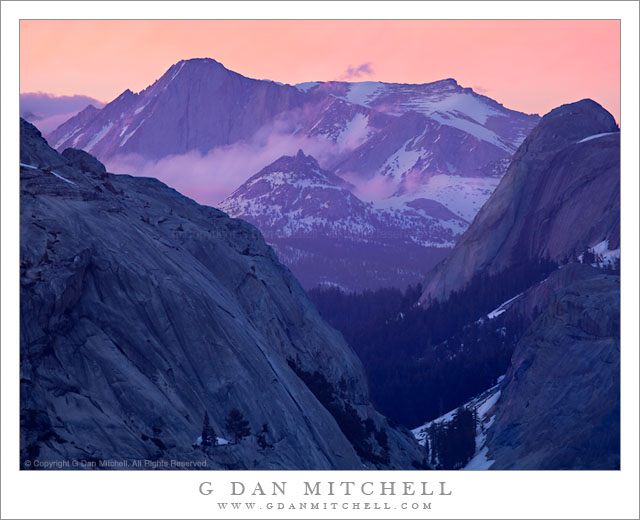
At about this point the light began to change in ways that were quite astonishing. I distinctly recall that as we were standing there looking east, at one point all of us suddenly looked back to the northwest in response to a sudden increase in the intensity of the light – it was almost as if someone had turned up the dimmer switch! I am certain that I heard at least one person actually gasp in amazement. As the color in the clouds continued to move west the light began to come from not just to the left but from brilliantly colorful clouds in almost all directions, and it filled even the depths of the canyon above Tenaya Lake with an intense wash of light. The most intense light color arrived at about 8:39:
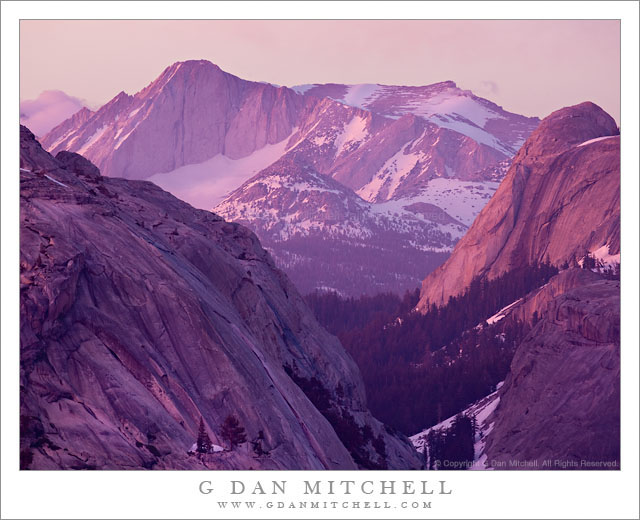
The color persisted for perhaps another five or six minutes, though its intensity gradually diminished, leaving only subtle color on the foreground domes just before the last direct light left the summit of Mount Conness. Believe it or not, there was yet one more photograph to be made. In the following photograph,
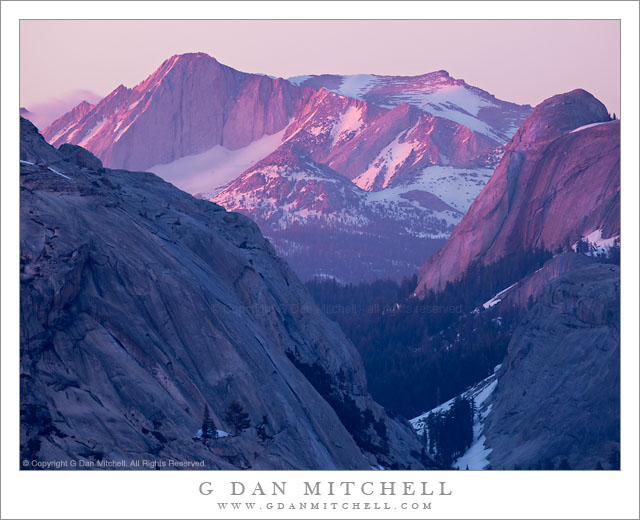
While trying to avoid being overly pedantic, I’d like to make a few points about this experience.
- Mountain light is amazing. (How’s that for starting out with a non-pedantic comment?)
- It is often as important to understand where the light is headed as it is to recognize where it is right now.
- Knowledge of your subject and especially of the conditions in the location can be invaluable when it comes to anticipating what might happen.
- Unless you really have something better to do, don’t pack up too early when shooting in the evening!
- There are no guarantees – I could have just as easily ended up with a sunset that was a variation on the light I saw an hour earlier.
- For every evening that produces magic light, you may well have to “be there” for nine others that don’t. On those other nine evenings, enjoy your surroundings as you pay your dues!
The Photograph Exposed series:
- A Photograph Exposed: “Submerged Boulders, Lake, and Cliffs” (2010)
- A Photograph Exposed: A Tale of Light (2011)
- A Photograph Exposed: Photography and Luck (2012)
- A Photograph Exposed: “San Francisco Skyline — Winter Fog and Haze” (2015)
- A Photograph Exposed: “Two Rocks, Morning, Racetrack Playa” (2015)
- A Photograph Exposed: “Two Islands, Fog” (2015)
- A Photograph Exposed: “Shoreline Reflections, Trees and Rocks” (2015)
- A Photograph Exposed: One Subject, Two Compositions (2015)
- A Photograph Exposed: Technique and Interpretation in Post (2015)
- A Photograph Exposed: Je Suis Bleu (2022)
 G Dan Mitchell is a California photographer and visual opportunist. Blog | About | Flickr | Twitter | Facebook | Google+ | 500px.com | LinkedIn | Email
G Dan Mitchell is a California photographer and visual opportunist. Blog | About | Flickr | Twitter | Facebook | Google+ | 500px.com | LinkedIn | Email
All media © Copyright G Dan Mitchell or others where indicated. Any use requires advance permission from G Dan Mitchell.
Discover more from G Dan Mitchell Photography
Subscribe to get the latest posts sent to your email.

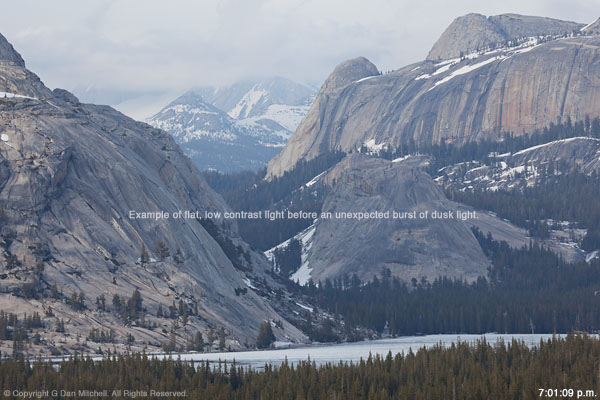
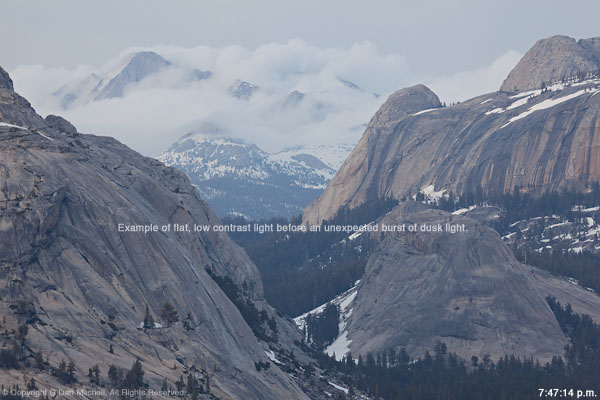

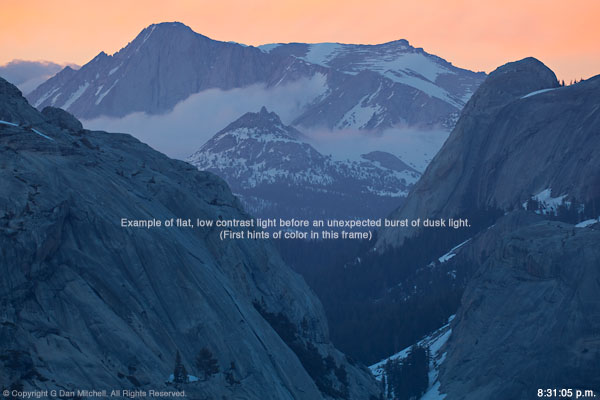
Michael, to extend your idea about “frustrating,” the only thing more frustrating that waiting for light that never comes (on an otherwise pleasant and beautiful Sierra evening or morning) is to leave or chose not to go, only to hear about what you missed!
You make another really important point in your post when you point out that you were “happily photographing patterns in the ice, in soft light” when the light didn’t look promising. I might paraphrase that as, “if you don’t see the light you came for, look for something else beautiful to photograph!” That soft light, which often comes in overcast conditions, can be some of the most beautiful light of all, in some ways more interesting than the brilliant colors of sunset.
Take care,
Dan
And, believe it or not, I think I’m actually going to coax one more photograph out of this series, for a total of three.
>6. For every evening that produces magic light, you may well have to “be there” for nine others that don’t. On those other nine evenings, enjoy your surroundings as you pay your dues!
Well put! Many times, on unpromising evenings like this, I’ve heard other photographers say, “Looks like it’s not going to happen tonight,” and start packing up. And nine times out of ten they’re right. But you and I have both seen unexpected late-day sunlight break through the clouds enough times to know it can happen – and to know how frustrating is it to see this light after you’ve packed up and started driving away!
As you saw, I was nearby on the same evening, and posted a photo on my blog of Tenaya Lake from around the same time. My EXIF data says 8:37, but my camera’s clock might be a few minutes off. Here’s a link if anyone’s interested:
http://www.michaelfrye.com/landscape-photography-blog/2011/06/20/tioga-pass-opens/
Down at Tenaya it didn’t look promising at all, but I was happily photographing patterns in the ice, in soft light, when I noticed a hint of purple in the sky to the east, and hurried over to a spot I’d scouted before as a possible foreground – if and when the sun broke through. It’s always good to be prepared, and know where you want to be if something happens.
Anyway, great post, with lots of great information on what you were thinking about that evening. And a beautiful photograph to cap it off!
Well done and explained. As the master of Mountain Light said: if it is good, shoot it, if it gets better, shoot it again!
Cheers, Harry
Two nights before this (Thurs the 16th) we were on the floor of the valley waiting for what mother nature would give us for the sunset on Half Dome and surrondings. In the late afternoon a thin haze had made most scenes pretty flat but we were hoping for better.
Around 6:30 some nice clouds built around Half Dome and I got some nice shots. I was hoping the clouds would last until sunset. An hour later the clounds around Half Dome had thined to just wispy ones and to the west the haze was filtering the sunshine again making everything flat and dull. Well we’ll just have to wait and see.
15 minutes later as the last light left Glacier Point the sun broke through again and stayed that way until long after sunset. Just some wispy clouds to go pink in the afterglow but still not bad.
Fantastic post, Dan. Thanks for posting the “sample” pictures — I recognized color like the “bad” pictures as being in a lot of my photos ;-)
Joe, I like to tell people that I make hundreds of bad photographs! No one but me usually gets to see them, though… ;-)
Dan
Great post – I have spent many evenings where I was “paying my dues” but its always great to be out there even if the light is uncooperative.
Great post Dan! Very interesting to hear what was going through your mind while waiting to see if the light would come together or simply fizzle out. I can definitely relate. Congrats on a couple of great photos!
“Never pack until its black!” – gotta’ remember that one! :-)
Great examples, Dan. “Never pack until it’s BLACK!” :)
Very interesting. Great example of why it’s worth waiting to the very end, you never really know what might happen with the light.